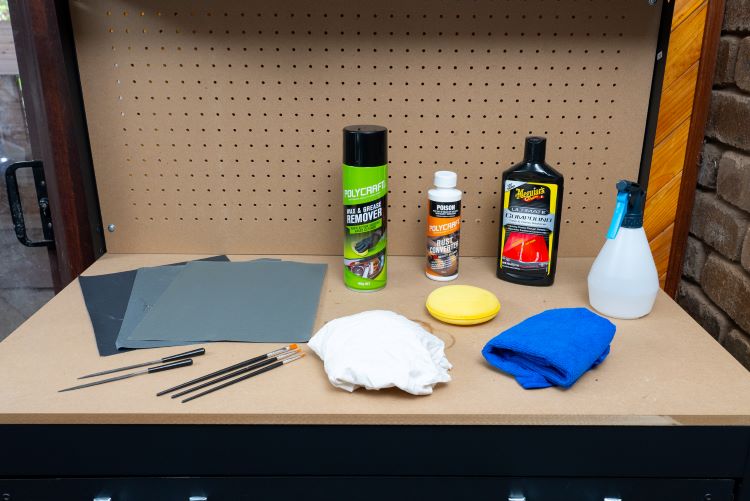How To Use Touch Up Paint
Overview
If your car looks great from a distance but is showing its age with a few paint chips and scratches; it might be time for some paint spot repairs with touch up paint. Not only will it have your car looking SUPER, but learning how to touch up car paint will protect your car from developing a serious rust problem later.
Selecting the Right Paint Colour
Repairing those paint spots correctly will require touch up paint that is matched to your vehicle colour code. You can usually find this printed in the front of the owner’s manual or service booklet, and on the build plate. The build plate is most often situated under the bonnet or inside one of the front door jambs.
With this paint colour code, you can have a small bottle of touch up paint mixed at Supercheap Auto to perfectly match your car.
Types of Paint Spots
The types of paint spots which can be repaired with touch up paint are usually small deep scratches and stone chips which have removed the paint back to primer or bare steel. By applying multiple layers of touch up paint, the damage can be filled in and sanded to match the factory finish. This will also prevent rust from occurring. Large scratches or scrapes and dents require further panel correction and spray painting, they cannot be repaired with touch up paint.
Items
Steps
Eliminate rust
If the scratch or stone chip is old, there may be some surface rust which has developed. Use the 800-grit sandpaper and the small metal file to remove this as much as possible, and try to minimise sanding outside of the damage. Wrapping your sandpaper around a small piece of wood may help.
Any remaining rust should be treated with the rust converter before you move onto step two.
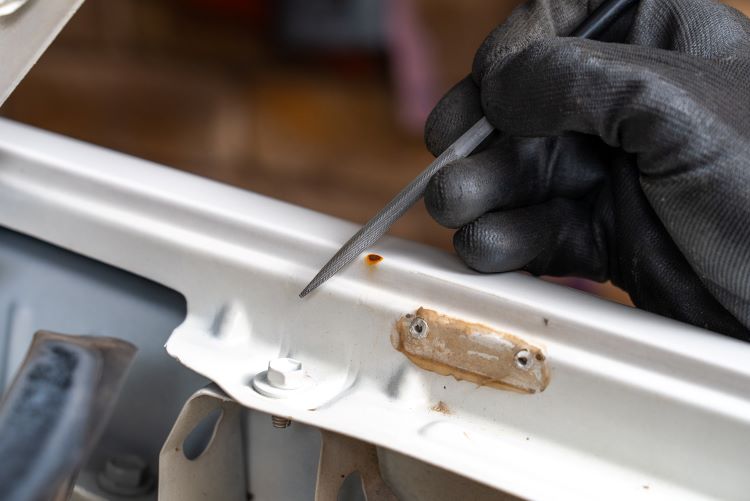
Prepare the paint spot
If you’re just after a quick touch up to guard against rust, you can clean the area with a cloth soaked in wax and grease remover; then move onto step three. If you’re seeking PERFECTION, read on.
Wrap a strip of 1500 grit sandpaper around a small, firm object and gently sand the centre and edges of the damage. This smooths microscopic rough edges which would otherwise show through later on.
If you used the 800-grit paper or file in step one, take care to smooth any scratches left by these.
To finish step two, wipe the area over with a cloth soaked in wax and grease remover.
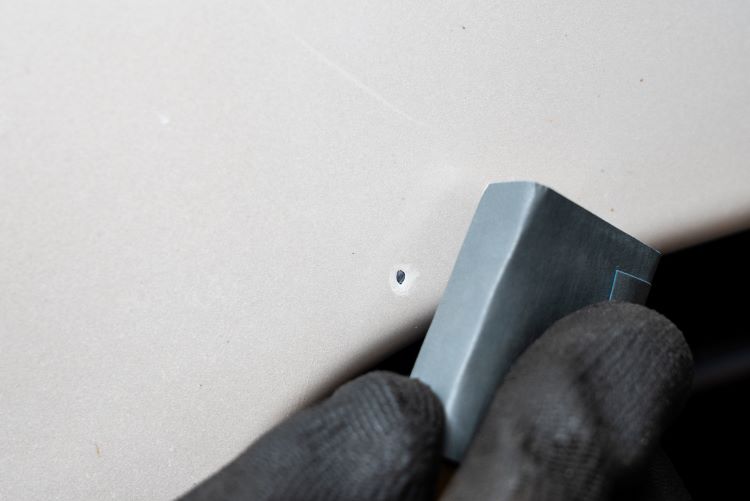
How to apply car touch up paint
Shake your touch up paint for around a minute. When repairing a scratch, apply the paint using a short brushing action in one direction only. For a paint chip, a dabbing motion is usually best.
Carefully work the paint into every part of the damage and don’t go too thick. If you go too thick, it will dry slowly or not at all. Instead, apply multiple thin coats with a fifteen-minute dry time between each, building the paint up until it is level with or even a little higher than the surrounding paint.
If you’re happy with this result you can call it a job done! But if you want a PERFECT result, we need to talk about how to smooth out touch up paint.
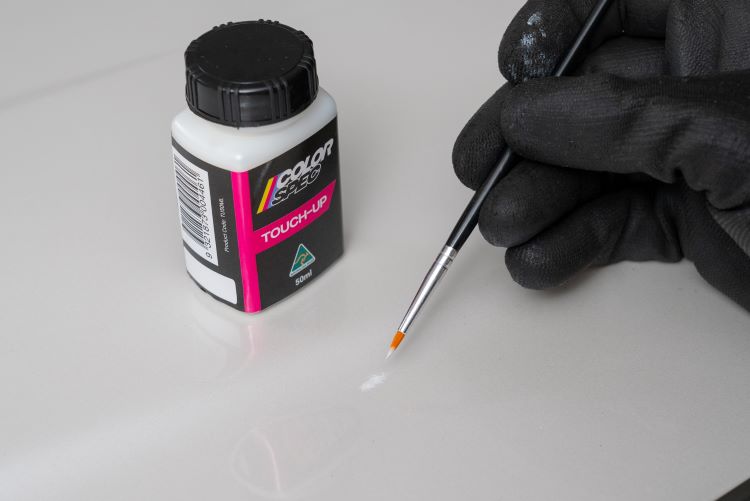
How to smooth out touch up paint on a car
To get your repair perfect, you’ll need to allow 48 hours for the paint to dry completely, and then do a little more sanding. Use some 800-grit sandpaper lubricated with a squirt of water to flatten your paint spot repair level with the surrounding paint. Try to sand only the touch up paint and not touch the surrounding paint.
Then move onto the 1500 grit sandpaper and expand your sanding area a little outside of the touch up. Work your way through the 1500 and 2000-grit sandpaper in the same way, expanding the sanding area just a little each time, and rubbing until the marks from the previous sandpaper are gone.
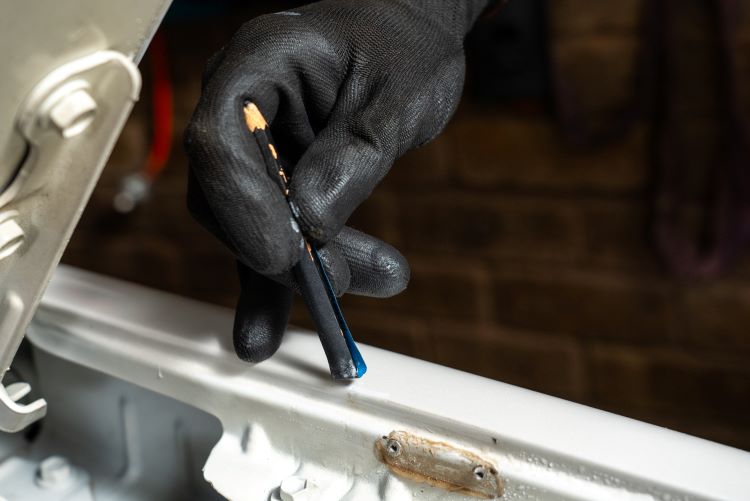
Polish the paint spot repair
At this point your repair should be just about invisible, but a haze will remain from the sanding. Apply a dab of polishing compound to your applicator and work the area with medium pressure. Wipe away the residue, and repeat if necessary until you have a perfect repair indistinguishable from the factory paint.
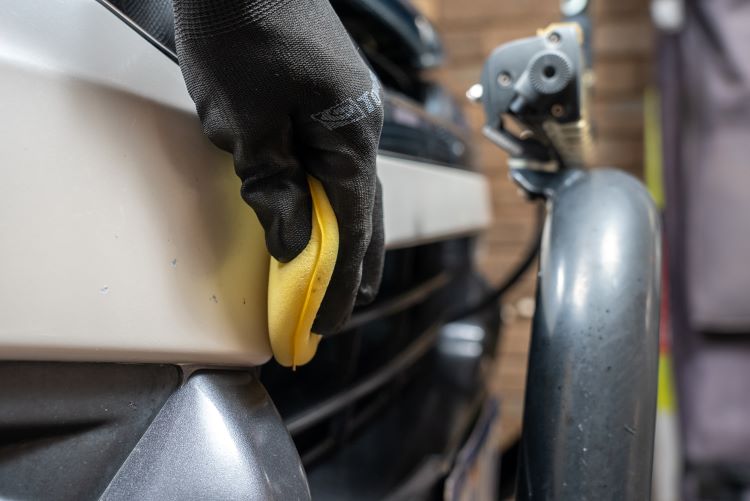
Tips
How long does car paint take to dry?
The drying time of car paint depends largely on the temperature and humidity in your area. On a hot, dry day the recoat time for your touch up paint could be as little as 5 minutes while on a cold day it will take 15 minutes or longer if the touch up paint is applied too thick.
The same applies for the total dry time. On a hot dry day it could be totally dry and ready to sand on the same day. In cooler weather it will be closer to the 48 hour mark.
Can I use car touch up paint on larger areas, such as scratches or small dents?
Touch up paint can be used anywhere that paint has been removed from your vehicle. On a small dent where the paint is intact; you will see no benefit from using touch up paint. In fact it will look much worse. If the panel has been dented and paint has been scratched away to reveal bare metal, primer, or raw plastic – you will see a small improvement and protect yourself against rust, but for a true repair you should seek the services of a paint shop.
Is it necessary to use a rust converter before applying car touch up paint?
If the paint spot to be repaired is on a plastic bumper, or it is very fresh damage on a steel surface; you will not need to use a rust converter before you apply touch up paint. If the damage has been left for a while and there is even a hint of orange or brown, you will need to remove as much as possible with a small file and 800 grit sandpaper and treat what remains with rust converter. Skipping this step will trap the rust and allow it to spread underneath the paint.
*Important information* - Click here to read more about our DIY Advice Terms and Conditions.
